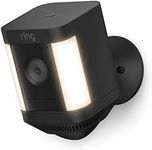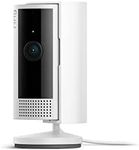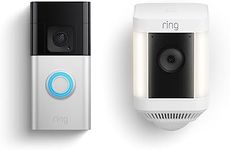Buying Guide for the Best Ring Cameras
When choosing a ring camera (or any smart doorbell camera), it's important to think about your home security needs, the layout of your entryway, and how you want to interact with visitors. The right camera will help you monitor your front door, communicate with guests, and keep your property safe. To make the best choice, you should understand the key features and how they relate to your daily life and home setup.Video ResolutionVideo resolution refers to the clarity and detail of the footage your camera captures. Higher resolution means a sharper image, making it easier to recognize faces or read small details. Common options include 720p (HD), 1080p (Full HD), and 2K or 4K (Ultra HD). If you just want basic monitoring, 720p may be enough, but for clearer images and better identification, 1080p or higher is recommended. Consider your need for detail—if you want to clearly see faces or license plates, go for higher resolution.
Field of ViewField of view is the width of the area the camera can see. A wider field of view means the camera can capture more of your porch or yard in a single frame. Typical ranges are from about 120° to 180°. If your entryway is wide or you want to see more of your surroundings, choose a camera with a larger field of view. For narrow spaces, a smaller field of view may be sufficient.
Power SourceRing cameras can be powered by batteries, hardwired to your existing doorbell wiring, or plugged into an outlet. Battery-powered models are easier to install and can be placed almost anywhere, but require regular recharging. Hardwired models offer continuous power but need existing wiring and a bit more installation effort. Plug-in models are a middle ground but need a nearby outlet. Choose based on your comfort with installation and whether you want to avoid recharging.
Motion DetectionMotion detection allows the camera to alert you when it senses movement. Some cameras offer basic motion detection, while others have advanced features like customizable motion zones or person detection. If you want to avoid false alerts from passing cars or animals, look for cameras with adjustable zones or smart detection. Think about how busy your street is and how much control you want over notifications.
Two-Way AudioTwo-way audio lets you speak to visitors through the camera using your phone or smart device. This is useful for greeting guests, giving instructions to delivery people, or deterring unwanted visitors. Most modern ring cameras include this feature, but check the quality and ease of use if you plan to use it often.
Night VisionNight vision enables the camera to see in low light or darkness, usually using infrared LEDs. This is important for monitoring your entryway at night or in poorly lit areas. Some cameras offer color night vision, which can provide more detail. If your porch is dark or you want 24/7 monitoring, make sure the camera has good night vision capabilities.
Smart Home IntegrationSmart home integration means the camera can work with other devices like smart locks, voice assistants, or security systems. If you already use smart home products, check if the camera is compatible with your ecosystem (like Alexa, Google Assistant, or Apple HomeKit). This can make controlling and automating your home security easier.
Cloud Storage and SubscriptionMost ring cameras store video clips in the cloud, which often requires a subscription. Some offer limited free storage, while others need a paid plan for full access to recordings and features. Consider how important it is for you to review past footage and whether you're comfortable with ongoing subscription costs. If you want to save and share videos, make sure you understand the storage options.
Weather ResistanceWeather resistance indicates how well the camera can handle rain, snow, heat, or cold. Look for cameras rated for outdoor use if you plan to install them outside. Check the operating temperature range and water resistance rating to ensure the camera will work reliably in your climate.










